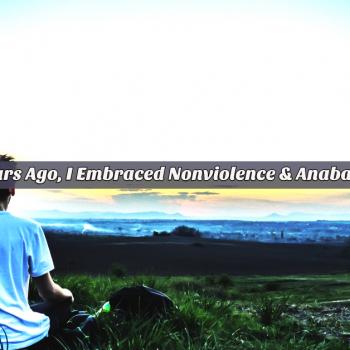The following is part of a fairly long series on the theology and practice of nonviolence. If you would like to read all of the posts, you can do so here.
————————————–
Now that we have looked at the two key texts in the New Testament that address the issue of nonviolence, there are other relevant texts and theological themes that should briefly be mentioned. Each of the following could take up several pages of investigation and reflection, but for our purposes I will highlight them with brevity.
- John 18.36 – “Jesus said, ‘My kingdom is not of this world. If it were, my servants would fight to prevent my arrest by the Jewish leaders. But now my kingdom is from another place.’” Here we have an indication that the kingdom of God is distinct from the empires of this world. In God’s kingdom, disciples do not resort to violence.
- Luke 6.27-36 – This passage is a parallel to the section of the Sermon on the Mount we dealt with in great detail, with various nuances. It has a strong emphasis on love of enemies.
- Luke 22.35-38 – Jesus tells his disciples that if they do not have a sword to “sell their cloak and buy one.” The disciples then grab two swords, only to hear Christ respond: “That’s enough!” This is not Jesus’ warning that when he gets taken that they will need to fight the authorities, but rather (as most commentators agree) the sword serves as a metaphor for the coming strife that they will face. Jesus responds to them out of frustration because they are too dense to understand. Imagine him raising his voice to say the equivalent of “enough of this!”[1] For a more detailed look, go here.
- 1 Peter 2.19-24 – Here, Christians are encouraged to “bear up under the pain of unjust suffering;” to “suffer for doing good;” to endure after the patter of Christ’s suffering as “an example… [to] follow in his steps.” Following Jesus in this way remembers how when he was insulted “he did not retaliate” or make “threats.” “Instead, he entrusted himself to him who judges justly.” This passage is a call to radical non-retaliation.
- Soldiers in the New Testament – It is commonly held that there are Roman soldiers that are commended for their faith. Some argue that it then follows that military service is acceptable for Christians for it is not condemned in these instances. On this, Richard B. Hays is quite insightful: “…precisely as Roman soldiers, they serve to dramatize the power of the Word of God to reach even the unlikeliest people.”[2] God reaches to unlikely places and peoples to reveal his grace, which serves to illuminate that military participation is similar to tax collectors and other sinners. It would be an argument from silence to claim that the rest of the NT texts about peacemaking are relativized simply because soldiers are not specifically told (in the text) to quit their jobs.
- Ephesians 6.10-18 & 2 Corinthians 10:3-4 – “For our battle is not against flesh and blood…” “…we do not wage war as the world does. The weapons we fight with are not the weapons of the world.” Clearly, both texts utilize military language and intentionally subvert it. The empire fights against flesh and blood enemies, but kingdom of God people use God’s spiritual armor against demonic powers.
- Revelation – This book, which is widely misunderstood, is about hope in the midst of a first century persecution. The victory of the slaughtered Lamb is the victory of the people of God. Evil is defeated “by the blood of the Lamb and by the word of their testimony” (12.11). This is not accomplished through human violence, but suffering. And even the controversial rider on the white horse, Jesus, need not be cause for dismissing the NT peace witness. Michael Gorman helps us to understand that the Lamb “comes on the white horse of victory bearing his own blood, reminding us that he will defeat the powers of evil as the Lamb, not with a sword in his hand but with a sword in his mouth. Just as it was the speech-act of faithful resistance to evil incarnate—the cross—that began the process of destroying evil, so also will the Word of God, the eternal gospel, kill death and de-create evil when the same Christ returns… It is this modus operandi of faithful, nonviolent action and speech, rooted in the life and witness of the Lamb, that is the way offered to, and ultimately required of, the Lamb’s followers.”[3]
- And briefly, Jesus with the whip in the temple. He clears it out quite forcefully, but there is NO INDICATION THAT HE HITS ANYONE! Enough said 🙂
Tomorrow we will get “practical” on this issues. I encourage you to review the previous posts so that you have a handle on the biblical argument, so that the practical application makes sense.
[1]. Joel B. Green, The Gospel of Luke (Grand Rapids, Mich.: W.B. Eerdmans Pub., 1997), 774-775.
[2]. Richard B. Hays, The Moral Vision of the New Testament: Community, Cross, New Creation: A Contemporary Introduction to New Testament Ethics (San Francisco: HarperSanFrancisco, 1996), 335.
[3]. Michael J. Gorman, Reading Revelation Responsibly: Uncivil Worship and Witness – Following the Lamb Into the New Creation (Eugene, OR: Cascade Books, 2011), 183-84.












